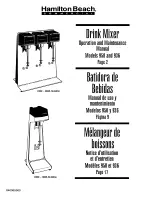
12
EURORACK MX2642A
Instrument Inputs
The stereo line inputs may be used as extra instrument inputs, especially if your MIDI keyboard or rack
supplies a pre-mixed stereo signal.
When using the stereo line inputs as extra instrument inputs, you have access to the aux buses for effects
processing.
Effects (Aux) Returns
The stereo line inputs may be used for returning the outputs of effects units.
Often it is useful to be able to send an effect into another effect. Echo sounds fatter when put through a stereo
chorus or phaser. To do this use the aux send facility of the stereo line inputs. Just be sure not to send to an
effect from its own output, creating feedback.
Certain stereo effects produce a perceived imbalance between the left and right channel levels.
When applying short left and right delays, the shortest one will always seem loudest. When pitch shifting up
and down in wide stereo to thicken a sound, the signal shifted upwards will seem louder than one that goes
down. In both cases use the BALANCE control (P28) to compensate.
+
When carrying any stereo imaging exercise, dont just rely on the control room monitors. Get
a pair of headphones and listen in stereo and in reverse stereo, just in case you have any
significant hearing discrepancies between your ears (and if you are in the habit of listening to
high sound pressure levels (SPLs), chances are you will).
Sometimes an engineer wants to narrow the stereo width of a reverb field. To do this you will have to come back
on two mono channels to get independent PAN for the left and right signals.
Each of A + B and C + D is assignable to all or any of main mix (S32), or subgroup pairs 1+2 and 3+4 (S30,
S31). Normally these will be assigned only to the main mix. However, provision is made for routing to the
subgroups, in case you want to record the signal to tape, or mixdown via a subgroup.
6.3 Metering
Main mix/Solo/PFL level is displayed on a pair of highly-accurate 12 segment bargraph peak meters. LEDs
indicate Power on (top left), +48 V phantom power present (top right), and whether the mono pre-fader listen
bus (bottom left) or the stereo solo bus (bottom right) is engaged.
6.4 CHANNEL MODE
The CHANNEL MODE switch (S37) determines whether solo-in-place or pre-fader listen is assigned to the
channel solo buttons.
SOLO
Solo is short for solo-in-place, and is the preferred method for auditioning an isolated signal, or
group of signals.
Whenever a SOLO button is pressed, all unselected channels are muted in the monitors. Stereo panning is
maintained. The solo bus is derived from the output of the channel pans, aux sends, stereo line inputs and
subgroups, too. The solo bus is always post-fader.
PFL
Pressing S37 once disengages the stereo solo bus, and replaces it with a separate mono PFL (pre-fader
listen) bus. Now any channel which is solo-ed, isnt. It is PFL-ed instead. PFL should always be used for
gain-setting.
6. MAIN SECTION
Downloaded from
www.Manualslib.com
manuals search engine








































